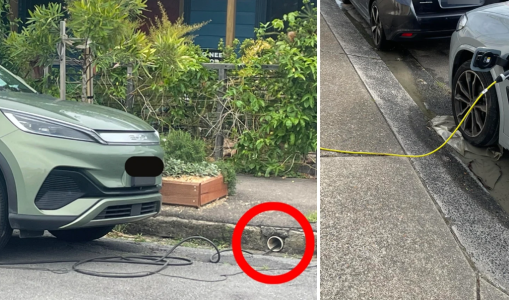Build Your Dreams charging photo reveals major issues in Australian neighborhoods
By
- Replies 27
As the world shifts towards greener transportation, adoption of electric vehicles (EVs) in Australia is accelerating.
However, this transition has challenges, particularly regarding the practicalities of charging these vehicles at home.
A recent incident involving a BYD electric car highlighted the issue of inadequate EV charging infrastructure in Australian neighbourhoods.
The peculiar detail in a photo of a BYD electric car charging in Newcastle has sparked a conversation about the lengths to which EV owners must go to power their vehicles.
The owner had ingeniously threaded the charging cable through a storm pipe under the footpath to avoid creating a trip hazard.
While this may seem considerate, it raises safety concerns, especially considering the combination of water and electricity.
This incident, along with another in Manly, Sydney, where an EV charger cord was seen lying across a footpath, highlights the ongoing difficulties faced by EV owners in urban areas.
The latter was called out by a passerby and criticised online as a 'selfish' act for creating a trip hazard.
These examples underscore the tension between the need for accessible charging options and the safety of pedestrians.
The rise in EV ownership is evident, with more than 85,000 battery electric (BEV) and plug-in hybrid vehicles (PHEV) sold in the year's first three quarters.
Predictions suggest that EV sales could surpass 100,000 in 2024, marking a significant milestone for Australia.
Despite this growth, the current infrastructure needs help to keep up, leading to creative but potentially hazardous solutions by EV owners.
Local councils are taking notice of these dangerous practices. In Sydney's Waverton, for example, a resident received a letter from the North Sydney Council threatening a $330 fine for charging his Tesla on the street.
The council, citing public safety concerns, urged residents to use one of the few public charging stations available.
However, this is easier said than done with only five stations in the area.
Other councils, such as Mosman Council, have echoed this sentiment, urging drivers to avoid placing EV chargers across footpaths.
In Sawtell on NSW’s Mid North Coast, complaints have arisen about neighbours running extension cables across footpaths to charge their cars.
Even a creative solution in Melbourne, where a Tesla owner used a fishing rod to create an overhead archway for their charging cord, was deemed a safety hazard by local councillors.
The Northern Beaches Council has weighed in, stating that they do not condone charging electric vehicles with cords running across footpaths, roads, or nature strips due to the risk of creating trip hazards.
They encourage residents to report any such incidents to their customer service team.
These incidents highlight a critical need for a more comprehensive and accessible EV charging network in Australia.
As EV adoption grows, federal and local governments must work together to expand the infrastructure to meet demand and ensure the safety of all residents.
Until then, EV owners and their neighbours will continue to navigate the challenges of charging in a world that has yet to adapt to electric mobility fully.
 How do you manage charging your EV at home? Have you encountered any issues with your local council or found creative solutions to avoid trip hazards? Share your stories and tips in the comments below.
How do you manage charging your EV at home? Have you encountered any issues with your local council or found creative solutions to avoid trip hazards? Share your stories and tips in the comments below.
However, this transition has challenges, particularly regarding the practicalities of charging these vehicles at home.
A recent incident involving a BYD electric car highlighted the issue of inadequate EV charging infrastructure in Australian neighbourhoods.
The peculiar detail in a photo of a BYD electric car charging in Newcastle has sparked a conversation about the lengths to which EV owners must go to power their vehicles.
The owner had ingeniously threaded the charging cable through a storm pipe under the footpath to avoid creating a trip hazard.
While this may seem considerate, it raises safety concerns, especially considering the combination of water and electricity.
This incident, along with another in Manly, Sydney, where an EV charger cord was seen lying across a footpath, highlights the ongoing difficulties faced by EV owners in urban areas.
The latter was called out by a passerby and criticised online as a 'selfish' act for creating a trip hazard.
These examples underscore the tension between the need for accessible charging options and the safety of pedestrians.
The rise in EV ownership is evident, with more than 85,000 battery electric (BEV) and plug-in hybrid vehicles (PHEV) sold in the year's first three quarters.
Predictions suggest that EV sales could surpass 100,000 in 2024, marking a significant milestone for Australia.
Despite this growth, the current infrastructure needs help to keep up, leading to creative but potentially hazardous solutions by EV owners.
Local councils are taking notice of these dangerous practices. In Sydney's Waverton, for example, a resident received a letter from the North Sydney Council threatening a $330 fine for charging his Tesla on the street.
The council, citing public safety concerns, urged residents to use one of the few public charging stations available.
However, this is easier said than done with only five stations in the area.
Other councils, such as Mosman Council, have echoed this sentiment, urging drivers to avoid placing EV chargers across footpaths.
In Sawtell on NSW’s Mid North Coast, complaints have arisen about neighbours running extension cables across footpaths to charge their cars.
Even a creative solution in Melbourne, where a Tesla owner used a fishing rod to create an overhead archway for their charging cord, was deemed a safety hazard by local councillors.
The Northern Beaches Council has weighed in, stating that they do not condone charging electric vehicles with cords running across footpaths, roads, or nature strips due to the risk of creating trip hazards.
They encourage residents to report any such incidents to their customer service team.
These incidents highlight a critical need for a more comprehensive and accessible EV charging network in Australia.
As EV adoption grows, federal and local governments must work together to expand the infrastructure to meet demand and ensure the safety of all residents.
Until then, EV owners and their neighbours will continue to navigate the challenges of charging in a world that has yet to adapt to electric mobility fully.
Key Takeaways
- Two incidents involving electric vehicle (EV) charging in public areas highlighted the current problems with EV charging infrastructure in Australian cities.
- One EV owner in Manly, Sydney, created a trip hazard by running a cable across a footpath.
- The rapid increase in EV ownership in Australia and the limited number of public charging stations are causing conflicts between EV drivers and local councils.
- Some councils are taking action against unsafe charging practices by threatening fines, and residents are encouraged to report any hazardous EV charging to their local councils.








